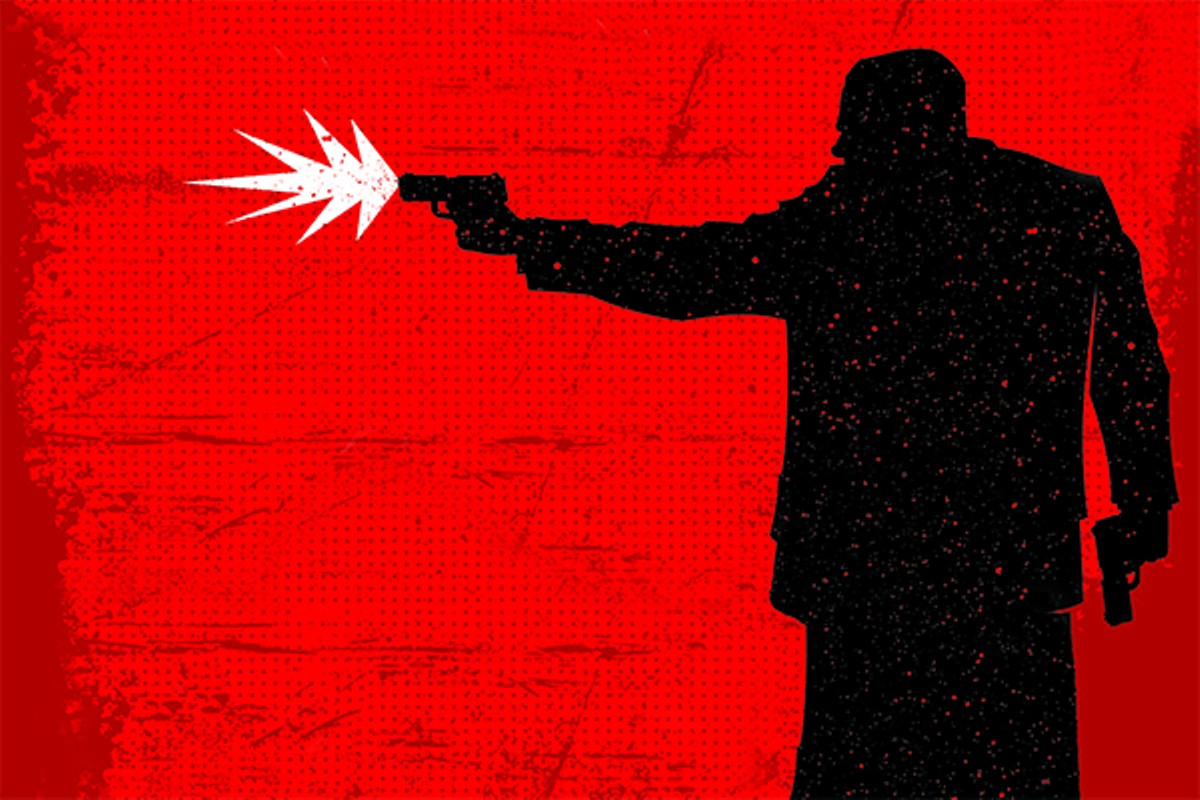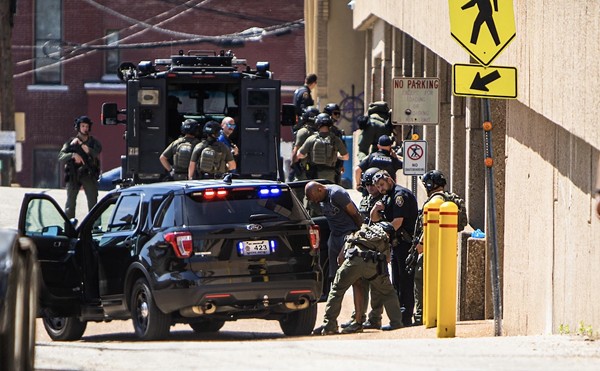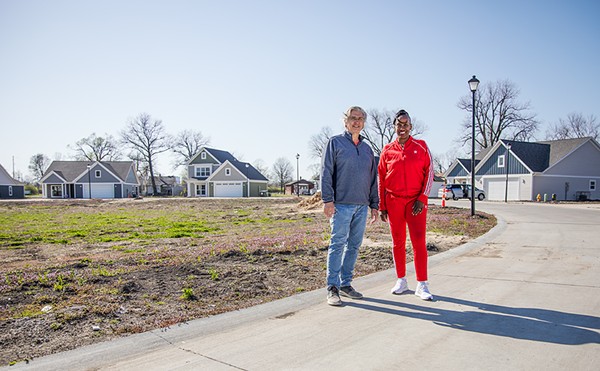On the night of Friday, September 25, Chris Sanna walked out of Busch Stadium, probably for the last time.
He and his brothers had just taken their mother to a Cardinals game. It was her 60th birthday. Sanna, a 43-year-old military veteran from House Springs, was departing early with his girlfriend in the ninth inning because he had to work the next morning.
Around 10:30 p.m. the couple headed east down Walnut Street and toward the Old Cathedral parking lot to fetch their car. That's when a short man with long dreadlocks sprung from an idling vehicle and demanded their valuables.
Sanna's girlfriend handed over her purse. The robber pulled a handgun. The couple tried to flee, but the assailant shot Sanna in the back. As the former soldier lay on the ground, the man rifled through his pockets, reportedly saying, "Bitch, give me all your stuff."
The bullet punctured Sanna's lungs and liver, and also severed part of his spine, paralyzing him. Doctors now say he may never walk again. A suspect — 31-year-old Kilwa C. Jones of the Gravois Park neighborhood — has already been arrested and charged for the act. Sanna's mother says she's relieved Jones can't victimize anyone else.
But Sanna surely won't be the last victim.
Crime in the city of St. Louis is rising. At the end of August, aggravated assaults were up 18 percent over last year. Robberies were up 36 percent.
Most alarmingly, homicides were up 60 percent — and this in a metropolis that last year suffered the nation's highest homicide rate among cities with more than 100,000 people, according to new U.S. Department of Justice statistics.
St. Louis is not alone in seeing a spike. In Milwaukee, murders are reportedly up 76 percent. Baltimore, Washington, D.C., New Orleans and Kansas City have all posted double-digit percent increases in this category.
Yet the city of St. Louis is on pace to hit 200 murders this year — a grim total not seen here in two decades. And the blame game has begun.
Chief of Police Sam Dotson is accusing circuit judges of being too lenient on dangerous criminals. Aldermen criticize Mayor Francis Slay for lacking a coherent strategy against crime — and are threatening to block funding for a new football stadium until he gets serious. The mayor, in turn, points out that legislation to hire more officers has been languishing in the board of aldermen for nearly a year now. And the cops we do have are either too aggressive or not aggressive enough, depending on whom you ask.
Meanwhile, the body count rises.
So what does the hard data say? Myths are many, and they cling stubbornly, but the actual data is important. Only by finding a common base of fact can we take a sober look at the problem — and then address it intelligently.
Forget the political posturing for a moment. Here are ten important facts about St. Louis' murder problem. Not all are politically correct. Not all point to easy solutions. But all are demonstrably true.
1. We’ve Been Here Before
The worst year on record for homicides in St. Louis was 1993, when the city saw 267 victims. That's more than what's anticipated for this year.
True, the city was also more populous back then, with about 387,000 inhabitants, compared to 317,000 today. So to meaningfully compare then and now, you have to look not at the raw number of victims, but at the ratio of victims per residents.
Even by that measure, the early '90s were worse.
In 1993 the city's homicide rate was 69 victims per 100,000 people, according to the DOJ. Last year, the city's rate was 50. This year, we may reach a rate of 63. That would be the highest in more than twenty years. It's a tragic number, but it's not exactly unprecedented.
Nor can we be sure that this year isn't just a temporary bump. Since 1998 the city's homicide rate has changed direction ten times, falling a total of 40 points and rising a total of 57.
That's a net rise, and it demands a response. Yet it doesn't totally clarify where we're headed — or for how long.
2. City Homicides Are Highly Concentrated
For years, researchers have observed how crimes tend to cluster on a map. But even Richard Rosenfeld, a criminologist at the University of Missouri-St. Louis who regularly consults with city police, was surprised when he recently crunched the numbers from 2000 through 2014. He found that half of St. Louis' violent crime was concentrated on just 5 percent of city blocks.
"I didn't expect it to be that extreme," says Rosenfeld. The professor declined to specify which city blocks suffered the most violence, because these "hot spots" are not necessarily consistent over time. Some flare up as others cool off.
"There's movement at the top of the list," he says.
A Riverfront Times analysis of police data certainly reveals a pattern: Since 2008, about 80 percent of homicides have occurred in just a third of city neighborhoods.
The vast majority of those neighborhoods — including the three with the highest numbers, Wells Goodfellow, JeffVanderLou and Baden — lie in north St. Louis, although a few, such as Dutchtown and Gravois Park, are on the south side (see map). And within such neighborhoods, Rosenfeld says, crime can vary sharply from block to block.
By contrast, dozens of neighborhoods in the central and southern corridors of the city have seen no more than three homicides since 2008. Some, such as South Hampton and Wydown Skinker, have seen zero.
"There's a perception that, 'I will be targeted if I go downtown,'" says Chief Dotson. "But the number of cases I see are few and far between."
The stats support Dotson's claim: Downtown and Downtown West each averaged fewer than three homicides annually from 2008 through 2014. Consider that figure next to the 23.3 million fans who went to a game at Busch Stadium during those years, to say nothing of Rams games, Blues games, festivals, concerts, museums, or even those who live and work downtown.
That's not to suggest that everything's rosy near the Arch. If you lump together Downtown and Downtown West, aggravated assaults are up 60 percent. Perhaps that's partly why former county police chief Tim Fitch recently proposed a lockbox for sports fans to check their guns at sporting events — some people feel safer packing a pistol while walking back to the car after a game.
And while robberies haven't increased in those two neighborhoods this year, they do sometimes turn fatal. Recall the case of the three teens parked behind the City Museum just after midnight on January 11. They were held up at gunpoint, and after a struggle ensued over one victim's purse, another — nineteen-year-old Robert Christman, a recent graduate of DeSmet Jesuit High School — was shot in the head and killed.
But when it comes to homicides in general, it's worth noting where this year's jump is occurring. Our statistical analysis shows the bulk of it — 72 percent, to be exact — has happened outside the downtown area and north of Highway 40.






